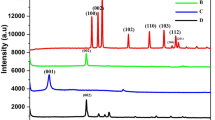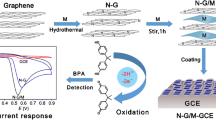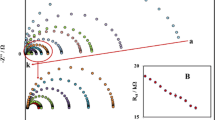Abstract
The graphene oxide-poly(ethyleneimine) dendrimer (GO–PEI) was synthesized and characterized by SEM, TEM, UV–Vis, FTIR, and Raman spectroscopies and further employed for the fabrication of modified glassy carbon electrode by a drop-cast method. The electrochemical behaviour of ortho-nitrophenol (o-NP) was investigated at the modified electrode, and the results of the investigation revealed that the material exhibited a significant reduction capability towards o-NP, an indication of sensitive electrochemical response. In addition, the modified electrode possessed an excellent electrochemical behaviour towards the redox of o-NP by combining the properties of both GO and PEI. Also, it was found that the o-NP can be separated indigenously from different potentials of nitrosophenol or hydroxyl aminophenol redox reaction. The peak currents showed a linear relationship with the concentration of o-NP in the range of 5–155 μM. The limit of detection of o-NP is low as 0.10 μM characterized by the signal-to-noise characteristics (S/N = 3). The relative standard deviation (RSD) for the three times determination towards o-NP is 0.12 %, which is highly specified, and reveals that this method has good properties such as reproducibility capability, selectivity, repeatability, and stability. Hence, the present GO–PEI-based o-NP sensors proved to be endeavouring for a broad range of applications related to the detection of trace amounts of phenolic compounds. In addition, the material was successfully employed for the treatment of industrially contaminated water during the removal of heavy metals (Fe3+, Ni2+, Cu2+, Pb2+, and Zn2+ ions).

















Similar content being viewed by others
References
Wang P, Xiao J, Liao A, Li P, Guo M, Xia Y, Li Z, Hiang X, Huang W (2015) Electrochemical determination of 4-nitrophenol using uniform nanoparticle film electrode of glass carbon fabricated facilely by square wave potential pulses. Electrochim Acta 176:448–455. doi:10.1016/j.electacta.2015.07.054
Isayev O, Rasulev B, Gorb L, Leszczynski J (2006) Structure-toxicity relationships of nitroaromatic compounds. Mol Divers 10:233–245. doi:10.1007/s11030-005-9002-4
Miró M, Cladera A, Estela JM, Cerdá V (2001) Dual wetting-film multi-syringe flow injection analysis extraction application to the simultaneous determination of nitrophenols. Anal Chim Acta 438:103–116. doi:10.1016/S0003-2670(00)01356-8
Perry DA, Son HJ, Cordova JS, Smith LG, Biris AS (2010) Adsorption analysis of nitrophenol isomers on silver nanostructures by surface-enhanced spectroscopy. J Colloid Interface Sci 342:311–319. doi:10.1016/j.jcis.2009.10.053
Belloli R, Barletta B, Bolzacchini E, Meinardi S, Orlandi M, Rindone B (1999) Determination of toxic nitrophenols in the almosphere by high-performance liquid chromatography. J Chromatogr A 846:277–281. doi:10.1016/S0021-9673(99)00030-8
Guo X, Wang Z, Zhou S (2004) The separation and determination of nitrophenol isomers by high-performance capillary zone electrophoresis. Talanta 64:135–139. doi:10.1016/j.talanta.2004.01.020
Alizadeh T, Ganjali MR, Norouzi P, Zare M, Zeraatkar A (2009) A novel high selective and sensitive para-nitrophenol voltammetric sensor, based on a molecularly imprinted polymer-carbon paste electrode. Talanta 79:1197–1203. doi:10.1016/j.talanta.2009.02.051
Buchholz KD, Pawliszyn J (1994) Optimization of solid-phase microextraction conditions for determination of phenols. Anal Chem 66:160–167. doi:10.1021/ac00073a027
Rosenstein B, Lewkowicz M, Kao HC, Korniyenko Y (2010) Ballistic transport in grapheme beyond linear response. Phy Rev B. 81:041416. doi:10.1103/PhysRevB.81.041416
Erogul S, Bas SZ, Ozmen M, Yildiz S (2015) A new electrochemical sensor based on Fe3O4 functionalized graphene oxide-gold nanoparticle composite film for simultaneous determination of catechol and hydroquinone. Electrochim Acta 186:302–313. doi:10.1016/j.electacta.2015.10.174
Arvidsson R, Molander S, Sanden BA (2013) Review of potential environment and health risks of the nanomaterial graphene. Hum Ecol Risk Assess 19:873–887. doi:10.1080/10807039.2012.702039
Brody AL (2006) Nano and food packaging technologies converge. Food Technol 60:92–94
Hu X, Zhou Q (2013) Health and ecosystem risks of graphene. Chem Rev 113:3815–3835. doi:10.1021/cr300045n
Gao W, Majumder M, Alemany LB, Narayanan TN, Ibarra MA, Pradhan BK, Ajayan PM (2011) Engineered graphite oxide materials for application in water purification. ACS Appl Mater Interfaces 3:1821–1826. doi:10.1021/am200300u
Arfin T, Mohammad F (2015) Dendrimer and its role for the advancement of nanotechnology and bioengineering. In: Wythers MC (ed) Advances in materials science research, vol 21. Nova Publishers, New York, pp 153–173
Arfin T, Mohammad F (2014) Thermodynamics and electrochemical characterization of core-shell type gold-coated superparamagnetic iron oxide nanocomposites. Adv Mat Lett 5:315–324. doi:10.5185/amlett.2014.amwc.1030
Jr Hummers WS, Offeman RE (1958) Preparation of graphitic oxide. J Am Chem Soc 80:1339–1339. doi:10.1021/ja01539a017
Cottineau T, Toupin M, Delahaye T, Brousse T, Belanger D (2005) Nanostructured transition metal oxides for aqueous hybrid electrochemical supercapacitors. Appl Phys A Mater Sci Process 82:599–606. doi:10.1007/s00339-005-3401-3
Toupin M, Brousse T, Belanger D (2004) Charge storage mechanism of MnO2 electrode used in aqueous electrochemical capacitor. Chem Mater 16:3184–3190. doi:10.1021/cm049649j
Li D, Müller MB, Gilje S, Kaner RB, Wallace GG (2008) Processable aqueous dispersions of graphene nanosheets. Nat Nanotechnol 3:101–105. doi:10.1038/nnano.2007.451
Li J, Liu C-Y, Liu L (2012) Au/graphene hydrogel: synthesis, characterization and its use for catalytic reduction of 4-nitrophenol. J Mater Chem 22:8426–8430. doi:10.1039/C2JM16386A
Fernȃndez-Merino MJ, Guardia L, Paredes JI, Villar-Rodil S, Solȋs-Fernȃndez P, Martȋnez-Alonso A, Tascȏn JMD (2010) Vitamin C is an ideal substitute for hydrazine in the reduction of graphene oxide suspensions. J Phys Chem C 114:6426–6432. doi:10.1021/jp100603h
Xu LQ, Yang WJ, Neoh KG, Kang ET, Fu GD (2010) Dopaime-induced reduction and dunctionalized of graphene oxide nanosheets. Macromolecules 43:8336–8339. doi:10.1021/ma101526k
Arfin T, Kumar C (2014) Synthesis, characterization, conductivity and antibacterial activity of ethyl cellulose manganese (II) hydrogen phosphate. Anal Bioanal Electrochem 6:403–421
Arfin T, Mohammad F (2016) Electrochemical, antimicrobial and anticancer effect of ethyl cellulose-nickel (II) hydrogen phosphate. Innov Corros Mater Sci 6:10–18. doi:10.2174/2352094906999160307182012
Xu CY, Zhang PX, Yan L (2001) Blue shift of Raman peak from coated TiO2 nanoparticles. J Raman Spectrosc 32:862–865. doi:10.1002/jrs.773
Yu PY, Cardona M (1996) Fundamentals of semiconductors: physics and material properties. Springer-Verlag, Berlin
Gurunathan S, Han JW, Dayem AA, Eppakayala V, Park M-R, Kwon D-N, Kim J-H (2013) Antibacterial activity of dithiothreitol reduced graphene oxide. J Ind Eng Chem 19:1280–1288. doi:10.1016/j.jiec.2012.12.029
Krishnamoorthy K, Veerpandian M, Mohan R, Kim S-J (2012) Investigation of Raman and photoluminescence studies of reduced graphene oxide sheets. Appl Phys A Mater Sci Process 106:501–506. doi:10.1007/s00339-011-6720-6
Shen J, Shi M, Yan B, Ma H, Li N, Hu Y (2010) Ye M (2010) Covalent attaching protein to graphene oxide via diimide-activated amidation. Colloid Surf B: Biointerfaces 81(434–438):434. doi:10.1016/j.colsurfb.2010.07.035
Lu J, Yang J-X, Wang J, Lim A, Wang S, Loh KP (2009) One-pot synthesis of fluorescent carbon nanoribbons, nanoparticles, and graphene by the exfoliation of graphite in ionic liquids. ACS Nano 3:2367–2375. doi:10.1021/nn900546b
Chen WF, Yan LF, Bangal PR (2010) Chemical reduction of graphene oxide to graphene by sulphur-containing compounds. J Phys Chem C 114:19885–19890. doi:10.1021/jp107131v
Song P, Zhang XY, Sun MX, Cui XL, Lin YH (2012) Synthesis of graphene nanosheets via oxalic acid-induced chemical reduction of exfoliated graphite oxide. RSC Adv 2:1168–1173. doi:10.1039/C1RA00934F
Stankovich S, Dikin DA, Piner RD, Kohlhaas KA, Kleinhammes A, Jia YY, Wu Y, Nguyen ST, Ruoff RS (2007) Synthesis of graphene-based nanosheets via chemical reduction of exfoliated graphite oxide. Carbon 45:1558–1565. doi:10.1016/j.carbon.2007.02.034
Park S, Ruoff RS (2009) Chemical methods for the production of graphenes. Nat Nanotechnol 4:217–224. doi:10.1038/nnano.2009.58
Rattana Chaiyakun S, Witit-anun N, Nuntawong N, Chindaudom P, Oaew S, Kedkeaw C, Limsuwan P (2012) Preparation and characterization of graphene oxide nanosheets. Procedia Eng 32:759–764. doi:10.1016/j.proeng.2012.02.009
Si Y, Samulski ET (2008) Synthesis of water soluble graphene. Nano Lett. 8:1679–1682. doi:10.1021/nl080604h
Ntsendwana B, Mamba BB, Sampath S, Arotiba OA (2012) Electrochemical detection of bisphenol a using graphene-modified glassy carbon electrode. Int J Electrochem Sci 7:3501–3512
Arfin T, Falch A, Kriek RJ (2012) Evaluation of charge density and the theory for calculating membrane potential for a nano-composite nylon-6,6 nickel phosphate membrane. Phys Chem Chem Phys 14:16760–16769. doi:10.1039/C2CP42683H
Arfin T, Mohammad F (2013) Synthesis, characterization and influence of electrolyte solutions towards the electrical properties of nylon-6,6 nickel carbonate membrane: test for the theory of uni-ionic potential based on thermodynamics of irreversible processes. In: Lefebure J (ed) Halides: chemistry. Physical Properties and Structural Effects, Nova Publishers, New York, pp 39–66
Ma HL, Zhang YW, Hu QH, Yan D, Yu ZZ, Zhai ML (2012) Chemical reduction and removal of Cr(VI) from acidic aqueous solution by ethylenediamine-reduced graphene oxide. J Mater Chem 22:5914–5916
Li J, Kuang D, Feng Y, Zhang F, Xu Z, Liu M (2012) A graphene oxide-based electrochemocal sensor for sensitive determination of 4-nitrophenol. J Hazard Mater 201–202:250–259. doi:10.1016/j.jhazmat.2011.11.076
El Mhammedi MA, Achak M, Bakasse M, Chtaini A (2009) Electrochemical determination of para-nitrophenol at apatite-modified carbon paste electrode: application in river water samples. J Hazard Mater 163:323–328. doi:10.1016/j.jhazmat.2008.06.126
Yang C (2004) Electrochemical determination of 4-nitrophenol using a single-wall carbon nanotube film-coated glassy carbon electrode. Microchim Acta 148:87–92. doi:10.1007/s00604-004-0240-4
Huang W, Yang C, Zhang S (2003) Simultaneous determination of 2-nitrophenol and 4-nitrophenol based on the multi-wall carbon nanotubes nafion-modified electrode. Anal Bioanal Chem 375:703–707. doi:10.1007/s00216-002-1745-5
Luz RCS, Damos FS, de Oliverira AB, Beck J, Kubota LT (2004) Voltammetric determination of 4-nitrophenol at a lithium tetracynoethylenide (LiTCNE) modified glassy carbon electrode. Talanta 64:935–942. doi:10.1016/j.talanta.2004.04.010
Zhang D-P, Wu W-L, Long H-Y, Liu Y-C, Yang Z-S (2008) Voltammetric behaviour of o-nitrophenol and damage to DNA. Int J Mol Sci 9:316–326. doi:10.3390/ijms9030316
Yao C, Sun H, Fu H-F, Tan Z-C (2015) Sensitive simultaneous determination of nitrophenol isomers at poly (p-aminobenzene sulfonic acid) film modified graphite electrode. Electrochim Acta 156:163–170. doi:10.1016/j.electacta.2015.01.043
Xu X, Liu Z, Zhang X, Duan S, Xu S, Zhou C (2011) & #x03B2;-cyclodextrin functionalized mesoporous silica for electrochemical selective sensor: simultaneous determination of nitrophenol isomers. Electrochim Acta 58:142–149. doi:10.1016/j.electacta.2011.09.015
Chu L, Han L, Zhang X (2011) Electrochemical simultaneous determination of nitrophenol isomers at nano-gold modified glassy carbon electrode. J Appl Electrochem 41:687–694. doi:10.1007/s10800-011-0281-4
Liu Z, Ma X, Zhang H, Lu W, Ma H, Hou S (2012) Simultaneous determination of nitrophenol isomers based on & #x03B2;-cyclodextrin functionalized reduced graphene oxide. Electroanal 24:1178–1185. doi:10.1002/elan.201100735
Luo L-Q, Zou X-L, Ding Y-P, Wu Q-S (2008) Derivative voltammetric direct simultaneous determination of nitrophenol isomers at a carbon nanotube modified electrode. Sensor Actuat B Chem 135:61–65. doi:10.1016/j.snb.2008.07.019
Tang J, Zhang L, Han G, Liu Y, Tang W (2015) Graphene-chitosan composite modified electrode for simultaneous detection of nitrophenol isomers. J Electrochem Soc 162:B267–B274. doi:10.1149/2.0811510jes
Acknowledgments
The authors thank University of Johannesburg and Aligarh Muslim University for providing facilities. We thank an anonymous reviewer for constructive criticism on earlier manuscript version.
Author information
Authors and Affiliations
Corresponding author
Rights and permissions
About this article
Cite this article
Arfin, T., Bushra, R. & Mohammad, F. Electrochemical sensor for the sensitive detection of o-nitrophenol using graphene oxide-poly(ethyleneimine) dendrimer-modified glassy carbon electrode. Graphene Technol 1, 1–15 (2016). https://doi.org/10.1007/s41127-016-0002-1
Received:
Revised:
Accepted:
Published:
Issue Date:
DOI: https://doi.org/10.1007/s41127-016-0002-1




